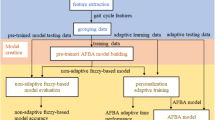Abstract
In this study a fuzzy logic classification system was used first to discriminate healthy subjects from patients rather than classifying those using Brunnstrom stages. Decision making was performed in two stages: feature extraction of gait signals and the fuzzy logic classification system which is used Tsukamato-type inference method. According to our signal feature extraction studies, we focused on temporal events and symetrical features of gait signal. Developed system has six inputs while four of them for temporal features evaluation rule block and two of them symmetrical features evaluation rule block. Our simulation test results showed that proposed system classify correctly 100% of subjects as patient and healthy elderly. The correlation coefficient was found 0.85 for classification to subjects to correct Brunnstrom stages. The results show that classifying patients becomes increasingly difficult linearly according to hemiplegia’s severity.
Preview
Unable to display preview. Download preview PDF.
Similar content being viewed by others
References
Baum, H.M., Robins, M.: The national survey of stroke. Survival and prevalence. Stroke 12(2), 159–168 (1981)
Morita, S., Yamamoto, H., Furuya, K.: Gait analysis of hemiplegic patients by measurement of ground reaction force. Scand. J. Rehabil. Med. 27(1), 37–42 (1995)
Morris, J.R.W.: Accelerometry-A technique for the measurement of human body movements. J. Biomechanics 6(6), 467–471 (1981)
L.A., Z.: Fuzzy Sets. Information and Control 8, 338–353 (1965)
Andriacchi, T.P.: Clinical applications of gait analysis. In: Proceedings of the 2nd North American Congress on Biomechanics. Proc. NACOB II, NACOB, Chicago, IL (1992)
Benedetti, M.G., Catani, F., Leardini, A, Pignotti, E, Giannini, S: Data management in gait analysis for clinical applications. Clin. Bio. mech. 13, 204–215 (1998)
Dubois, D., Prade, H.: An introduction to fuzzy systems. Clin. Chim. Acta 270, 3–29 (1998)
Sekine, M., Tamura, T., Akay, M., Fujimoto, T., Togawa, T., Fukui, Y.: Discrimination of Walking Patterns using Wavelet-Based Fractal Analysis. IEEE Transactions on Neural Systems and Rehabilitation Engineering 10(3), 188–196 (2002)
Dubois, D., Prade, H.: An introduction to fuzzy systems. Clin. Chim. Acta. 270, 3–29 (1998)
Kuncheva, L.I., Steimann, F.: Fuzzy diagnosis. Artif. Intell. Med. 16, 121–128 (1999)
Nauck, D., Kruse, R.: Obtaining interpretable fuzzy classification rules from medical data. Artif. Intell. Med. 16, 149–169 (1999)
Usher, J., Campbell, D., Vohra, J., Cameron, J.: A fuzzy logic-controlled classifier for use in implantable cardioverter defibrillators. Pace-Pacing Clin Electrophysiol 22, 183–186 (1999)
Belal, S.Y., Taktak, A.F.G., Nevill, A.J., Spencer, S.A., Roden, D., Bevan, S.: Automatic detection of distorted plethysmogram pulses in neonates and paediatric patients using an adaptive-network-based fuzzy inference system. Artif. Intell. Med. 24, 149–165 (2002)
Guler, I., Ubeyli, E.D.: Application of adaptive neuro-fuzzy inference system for detection of electrocardiographic changes in patients with partial epilepsy using feature extraction. Expert Syst. Appl. 27(3), 323–330 (2004)
Ubeyli, E.D., Guler, I.: Automatic detection of erythemato-squamous diseases using adaptive neuro-fuzzy inference systems. Comput. Biol. Med. 35(5), 421–433 (2005)
Ubeyli, E.D., Guler, I.: Adaptive neuro-fuzzy inference systems for analysis of internal carotid arterial Doppler signals. Comput. Biol. Med. 35, 687–702 (2005)
Bussmann, J.B.J., Damen, L., Stam, H.J.: Analysis and decomposition of signals obtained by thigh-fixed uni-axial accelerometry during normal walking. Med. Biol. Eng. Comput. 38, 632–638 (2000)
Evans, A.L., Duncan, G., Gilchrist, W.: Recording accelerations in body movements. Med.& Biol. Eng. & Comput. 29, 102–104 (1991)
Sadeghi, H., Allard, P., Prince, F., Labelle, H.: Symmetry and Limb dominance in able-bodied gait:a review. Gait and Posture 12, 34–45 (2000)
Aminian, K., Rezahhanlou, K., Andres, E., Fritsch, C., Leyvraz, P.F., Robert, P.: Temporal feature estimation during walking using miniature accelerometers: an analysis of gait improvement after hip arthroplasty. Medical & Biological Engineering & Computing 37, 686–691 (1999)
Robinson, R.O., Herzog, W., Nigg, B.M.: Use of force platform variables to quantify the effects of chiropractic manipulation on gait symmetry. J. Manipulative Physiol. Ther. 10, 172–176 (1987)
Tsukamoto, Y.: An Approach to Fuzzy Reasoning Model. In: Advances in fuzzy Set Theory and Applications, North-Holland, Amsterdam (1979)
Author information
Authors and Affiliations
Editor information
Rights and permissions
Copyright information
© 2007 Springer-Verlag Berlin Heidelberg
About this paper
Cite this paper
Yardimci, A. (2007). Fuzzy Logic Based Gait Classification for Hemiplegic Patients. In: R. Berthold, M., Shawe-Taylor, J., Lavrač, N. (eds) Advances in Intelligent Data Analysis VII. IDA 2007. Lecture Notes in Computer Science, vol 4723. Springer, Berlin, Heidelberg. https://doi.org/10.1007/978-3-540-74825-0_31
Download citation
DOI: https://doi.org/10.1007/978-3-540-74825-0_31
Publisher Name: Springer, Berlin, Heidelberg
Print ISBN: 978-3-540-74824-3
Online ISBN: 978-3-540-74825-0
eBook Packages: Computer ScienceComputer Science (R0)




